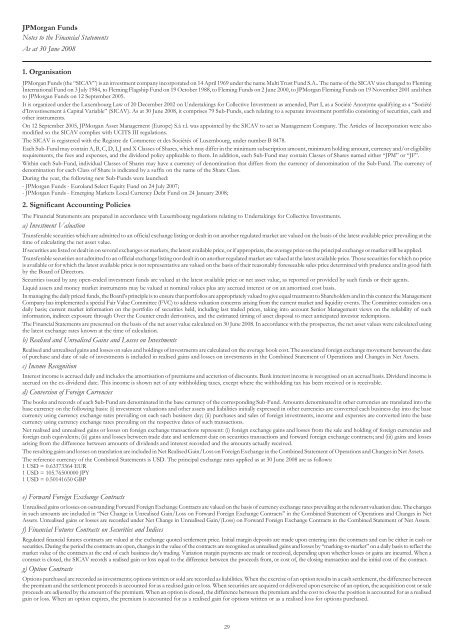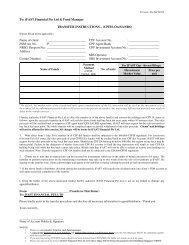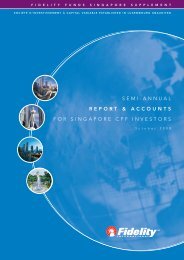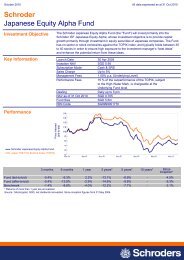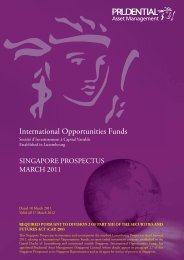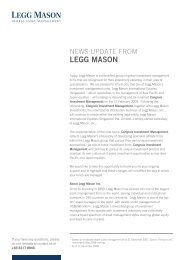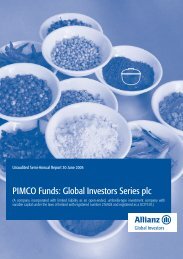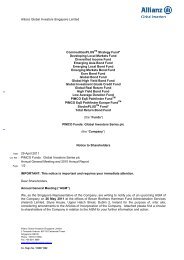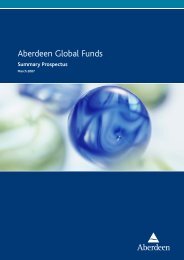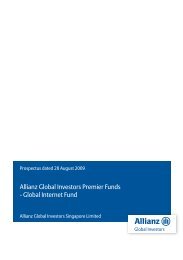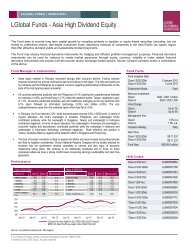Jpmorgan Funds - Fundsupermart.com
Jpmorgan Funds - Fundsupermart.com
Jpmorgan Funds - Fundsupermart.com
You also want an ePaper? Increase the reach of your titles
YUMPU automatically turns print PDFs into web optimized ePapers that Google loves.
JPMorgan <strong>Funds</strong><br />
Notes to the Financial Statements<br />
As at 30 June 2008<br />
1. Organisation<br />
JPMorgan <strong>Funds</strong> (the “SICAV”) is an investment <strong>com</strong>pany incorporated on 14 April 1969 under the name Multi Trust Fund S.A.. The name of the SICAV was changed to Fleming<br />
International Fund on 3 July 1984, to Fleming Flagship Fund on 19 October 1988, to Fleming <strong>Funds</strong> on 2 June 2000, to JPMorgan Fleming <strong>Funds</strong> on 19 November 2001 and then<br />
to JPMorgan <strong>Funds</strong> on 12 September 2005.<br />
It is organized under the Luxembourg Law of 20 December 2002 on Undertakings for Collective Investment as amended, Part I, as a Société Anonyme qualifying as a “Société<br />
d’Investissement à Capital Variable” (SICAV). As at 30 June 2008, it <strong>com</strong>prises 79 Sub-<strong>Funds</strong>, each relating to a separate investment portfolio consisting of securities, cash and<br />
other instruments.<br />
On 12 September 2005, JPMorgan Asset Management (Europe) S.à r.l. was appointed by the SICAV to act as Management Company. The Articles of Incorporation were also<br />
modified so the SICAV <strong>com</strong>plies with UCITS III regulations.<br />
The SICAV is registered with the Registre de Commerce et des Sociétés of Luxembourg, under number B 8478.<br />
Each Sub-Fund may contain A, B, C, D, I, J and X Classes of Shares, which may differ in the minimum subscription amount, minimum holding amount, currency and/or eligibility<br />
requirements, the fees and expenses, and the dividend policy applicable to them. In addition, each Sub-Fund may contain Classes of Shares named either “JPM” or “JF”.<br />
Within each Sub-Fund, individual Classes of Shares may have a currency of denomination that differs from the currency of denomination of the Sub-Fund. The currency of<br />
denomination for each Class of Share is indicated by a suffix on the name of the Share Class.<br />
During the year, the following new Sub-<strong>Funds</strong> were launched:<br />
- JPMorgan <strong>Funds</strong> - Euroland Select Equity Fund on 24 July 2007;<br />
- JPMorgan <strong>Funds</strong> - Emerging Markets Local Currency Debt Fund on 24 January 2008;<br />
2. Significant Accounting Policies<br />
The Financial Statements are prepared in accordance with Luxembourg regulations relating to Undertakings for Collective Investments.<br />
a) Investment Valuation<br />
Transferable securities which are admitted to an official exchange listing or dealt in on another regulated market are valued on the basis of the latest available price prevailing at the<br />
time of calculating the net asset value.<br />
If securities are listed or dealt in on several exchanges or markets, the latest available price, or if appropriate, the average price on the principal exchange or market will be applied.<br />
Transferable securities not admitted to an official exchange listing nor dealt in on another regulated market are valued at the latest available price. Those securities for which no price<br />
is available or for which the latest available price is not representative are valued on the basis of their reasonably foreseeable sales price determined with prudence and in good faith<br />
by the Board of Directors.<br />
Securities issued by any open-ended investment funds are valued at the latest available price or net asset value, as reported or provided by such funds or their agents.<br />
Liquid assets and money market instruments may be valued at nominal values plus any accrued interest or on an amortised cost basis.<br />
In managing the daily priced funds, the Board’s principle is to ensure that portfolios are appropriately valued to give equal treatment to Shareholders and in this context the Management<br />
Company has implemented a special Fair Value Committee (FVC) to address valuation concerns arising from the current market and liquidity events. The Committee considers on a<br />
daily basis; current market information on the portfolio of securities held, including last traded prices, taking into account Senior Management views on the reliability of such<br />
information, indirect exposure through Over the Counter credit derivatives, and the estimated timing of asset disposal to meet anticipated investor redemptions.<br />
The Financial Statements are presented on the basis of the net asset value calculated on 30 June 2008. In accordance with the prospectus, the net asset values were calculated using<br />
the latest exchange rates known at the time of calculation.<br />
b) Realised and Unrealised Gains and Losses on Investments<br />
Realised and unrealised gains and losses on sales and holdings of investments are calculated on the average book cost. The associated foreign exchange movement between the date<br />
of purchase and date of sale of investments is included in realised gains and losses on investments in the Combined Statement of Operations and Changes in Net Assets.<br />
c) In<strong>com</strong>e Recognition<br />
Interest in<strong>com</strong>e is accrued daily and includes the amortisation of premiums and accretion of discounts. Bank interest in<strong>com</strong>e is recognised on an accrual basis. Dividend in<strong>com</strong>e is<br />
accrued on the ex-dividend date. This in<strong>com</strong>e is shown net of any withholding taxes, except where the withholding tax has been received or is receivable.<br />
d) Conversion of Foreign Currencies<br />
The books and records of each Sub-Fund are denominated in the base currency of the corresponding Sub-Fund. Amounts denominated in other currencies are translated into the<br />
base currency on the following basis: (i) investment valuations and other assets and liabilities initially expressed in other currencies are converted each business day into the base<br />
currency using currency exchange rates prevailing on each such business day; (ii) purchases and sales of foreign investments, in<strong>com</strong>e and expenses are converted into the base<br />
currency using currency exchange rates prevailing on the respective dates of such transactions.<br />
Net realised and unrealised gains or losses on foreign exchange transactions represent: (i) foreign exchange gains and losses from the sale and holding of foreign currencies and<br />
foreign cash equivalents; (ii) gains and losses between trade date and settlement date on securities transactions and forward foreign exchange contracts; and (iii) gains and losses<br />
arising from the difference between amounts of dividends and interest recorded and the amounts actually received.<br />
The resulting gains and losses on translation are included in Net Realised Gain/Loss on Foreign Exchange in the Combined Statement of Operations and Changes in Net Assets.<br />
The reference currency of the Combined Statements is USD. The principal exchange rates applied as at 30 June 2008 are as follows:<br />
1 USD = 0.63373364 EUR<br />
1 USD = 105.76500000 JPY<br />
1 USD = 0.50141650 GBP<br />
e) Forward Foreign Exchange Contracts<br />
Unrealised gains or losses on outstanding Forward Foreign Exchange Contracts are valued on the basis of currency exchange rates prevailing at the relevant valuation date. The changes<br />
in such amounts are included in “Net Change in Unrealised Gain/Loss on Forward Foreign Exchange Contracts” in the Combined Statement of Operations and Changes in Net<br />
Assets. Unrealised gains or losses are recorded under Net Change in Unrealised Gain/(Loss) on Forward Foreign Exchange Contracts in the Combined Statement of Net Assets.<br />
f) Financial Futures Contracts on Securities and Indices<br />
Regulated financial futures contracts are valued at the exchange quoted settlement price. Initial margin deposits are made upon entering into the contracts and can be either in cash or<br />
securities. During the period the contracts are open, changes in the value of the contracts are recognised as unrealised gains and losses by “marking-to-market” on a daily basis to reflect the<br />
market value of the contracts at the end of each business day’s trading. Variation margin payments are made or received, depending upon whether losses or gains are incurred. When a<br />
contract is closed, the SICAV records a realised gain or loss equal to the difference between the proceeds from, or cost of, the closing transaction and the initial cost of the contract.<br />
g) Option Contracts<br />
Options purchased are recorded as investments; options written or sold are recorded as liabilities. When the exercise of an option results in a cash settlement, the difference between<br />
the premium and the settlement proceeds is accounted for as a realised gain or loss. When securities are acquired or delivered upon exercise of an option, the acquisition cost or sale<br />
proceeds are adjusted by the amount of the premium. When an option is closed, the difference between the premium and the cost to close the position is accounted for as a realised<br />
gain or loss. When an option expires, the premium is accounted for as a realised gain for options written or as a realised loss for options purchased.<br />
29


